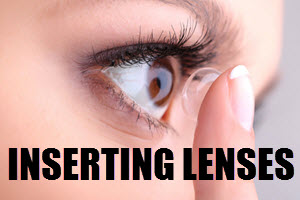At the time of writing, a lot of truly fascinating research project are going on and we might see some extremely innovative contact lenses being launched in the nearby future. Experts from fields such as chemistry, biology, microelectronics and ophthalmology are working together to take contact lenses to the next level.

Contact lenses that help you manage your allergies
For many people dealing with allergies, having the eyes react to allergens by becoming red, swollen, itchy and tear-filled is a common problem. Oral medications impacts the whole body and eye drops also have their downsides, but what if your contact lenses could dispense antihistamines directly into your eyes?
Johnson & Johnson has developed a disposable contact lens that comes preloaded with the medicine ketotifen, a second-generation noncompetitive H1-antihistamine and mast cell stabilizer.
The Johnson & Johnson ketotifen lens is predicted to be especially helpful to clients who are currently using contact lenses and have to remove them to apply antihistamine eye drops.
At the time of writing, the ketotifen lens has successfully made it through phase three clinical trials, but is not yet approved for consumer use.
Contact lenses that stop corneal melting
Corneal melting ulcers are a serious condition where a corneal ulcer is associated with progressive loss of corneal stroma in a dissolving fashion. It can be caused by various culprits, including certain bacteria and fungi, but can also be the result of an autoimmune disease, chemical burns or surgery. Examples of autoimmune conditions that are known to sometimes trigger an uncontrolled production of MMPs are rheumatoid arthritis, lupus and Stevens-Johnson syndrome.
Researchers at the University of New Hampshire have now developed a hydrogel contact lense that removes extra zinc from the cornea, thus stopping corneal melting caused by the uncontrolled production of certain zinc-dependent enzymes called matrix metalloproteinases (MMPs). (MMPs are produced by the patient’s immune cells in the cornea.)
“Most of the current MMP inhibitors used to treat this condition work by binding to the zinc ions within the MMPs,” says Kyung Jae Jeong, assistant professor of chemical engineering at the University of New Hampshire.“However, once injected into the body, the MMP inhibitors travel through the blood stream and entire body and can cause severe side effects because they are binding with and deactivating the zinc ions in other tissue. Our hydrogel works entirely differently because it is localized, just in the eye, and deactivates MMPs by eliminating the zinc ions from the cornea. And since it would be a contact lens, if there were any issues, the patient would simply remove it.”
Contact lenses that measures your blood sugar
Researchers in South Korea have developed a contact lens that will monitor your blood sugar levels, thus letting people with diabetes know their blood sugar levels without requiring a blood sample.
This is not the first time someone has attempting to create something like this, but the Korean researchers led by Jihun Park at the Ulsan National Institute of Science and Technology are notable because they have come up with an updated lens that is much more comfortable to wear (it is used from flexible materials). Also, a warning signal will alert the user as soon as the blood sugar level reaches an unhealthy level.



 Cosmetic contact lenses
Cosmetic contact lenses